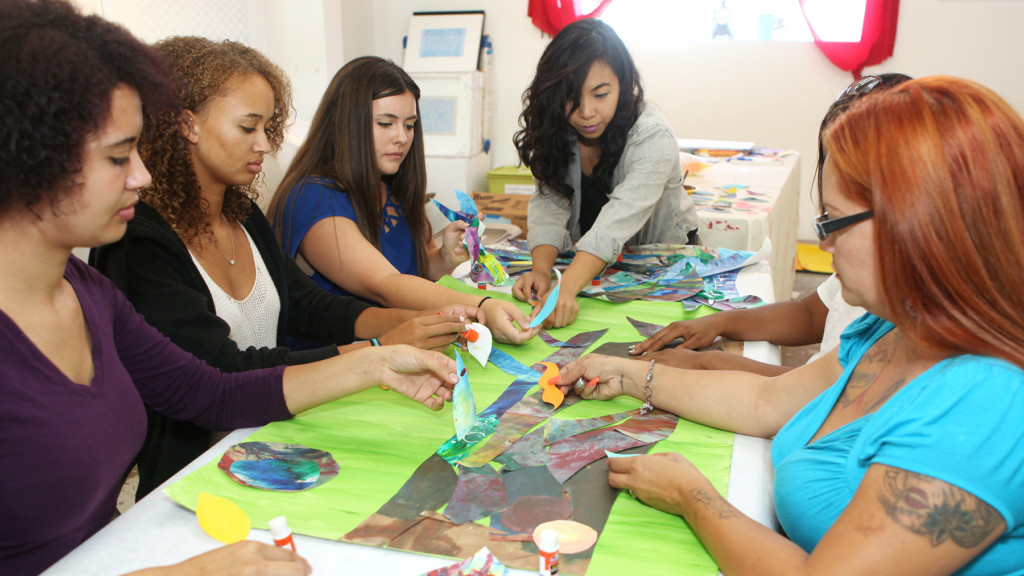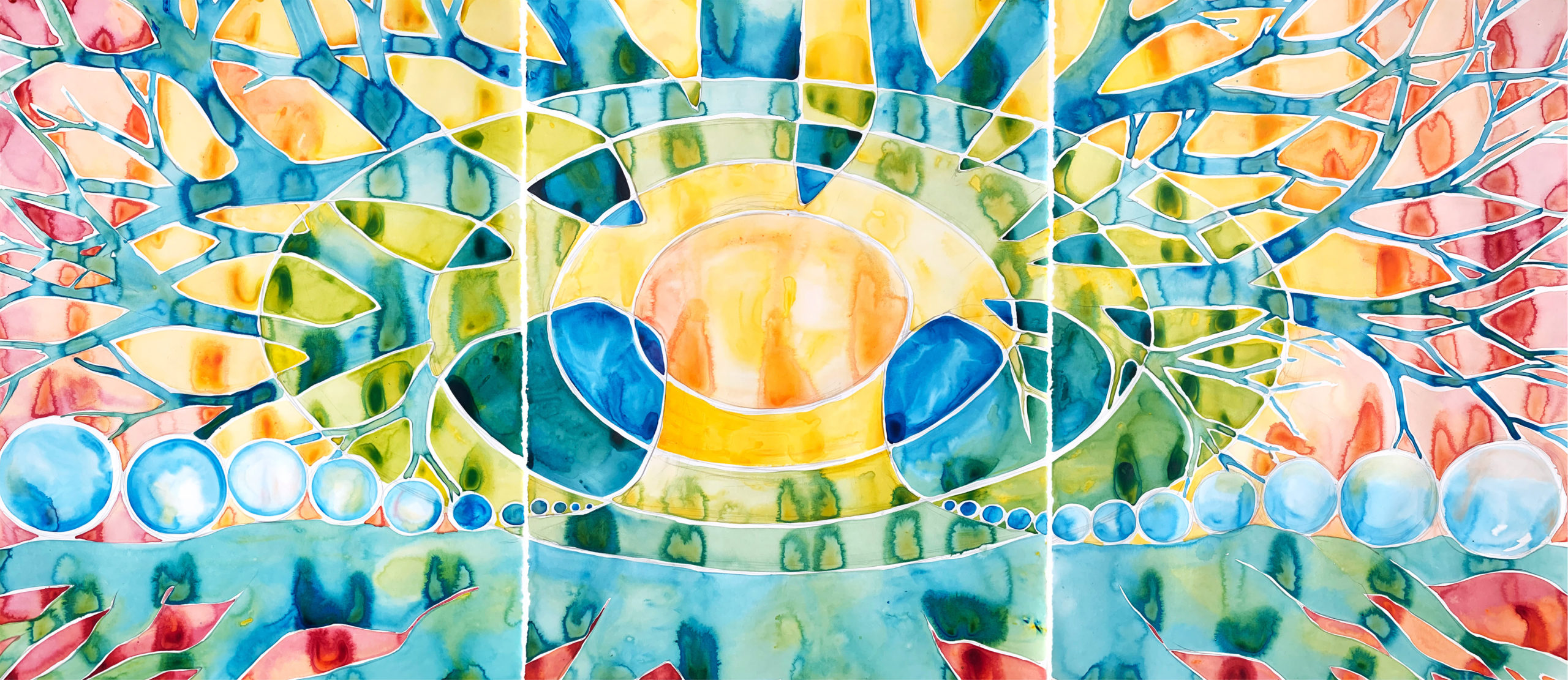by Kat Mardo
AWBW Outreach Coordinator and Windows Facilitator
Los Angeles, California
Storytelling – the act of sharing a piece of your life and your heart through words, weaving pictures, ideas, and emotions for a listener – is a form of art that I have a very special connection with.
As a theater major I became infinitely curious about all aspects of human behavior and expression, particularly expression through language. These expressions are everywhere. Everyone has a story to tell if we take the time to listen, truly listen.
A great deal of what I learned as a theater major serves me now in my role at AWBW, as a staff member and as a co-trainer in our 2 day virtual live trainings. When we listen deeply we connect differently. We form relationships. At AWBW, I am able to merge my love of listening and storytelling with the exploration of self-awareness that emerges through the artistic process. Together, these experiences have led me to the following tips on how listening can be done from a place of active awareness and authenticity.
We often think of art as a tangible creation – something visual. I invite you to consider that time, space, and connection between a speaker and a listener is also art. Through the sharing of our stories, words, and lives, we co-create a living, breathing act of art. It is my hope that these tips support you in creating connections in your world.
Tip #1: Set an Intention
Listening is a skill we can actively cultivate, like learning to ride a bike or playing the piano. New skills take practice, and our capacity for listening can grow and evolve when viewed through this lens. We can approach a listening practice by first setting the intention to truly be present. We know that the mind affects the body and the power of intention is real. By consciously committing to being present as we listen, we are showing up to the moment with purpose. Once we have practiced the skill of being present, so much so that it is now as easy as “riding a bike,” you can add other layers to your intention. Such as inviting curiosity and a genuine openness to the moment.
Tip #2: Identify an Anchor
Once the intention is established, it can be helpful to identify an anchor. Something that will guide you back to listening, if and when you drift away, which is natural and to be expected. An anchor can be your breath, a physical sensation, a sound, a visual point in the environment – anything that can serve as a gentle pull back into the “here and now.” An anchor can support you in re-engaging with your intention, involve your senses, and guide your awareness back to the listening and the present moment. You can use an anchor to help you be where you are.
Tip #3: Be Ready to Learn
Listening to understand rather than to respond is an integral element of building a listening practice and can be quite challenging. How often do we find ourselves in dialogue or conversation, and as someone else is speaking we are formulating our response, anxiously awaiting their last words in order to jump in with ours? This has been my particular area of difficulty with my listening practice. I constantly find myself with an enthusiastic excitement to connect and relate that I am eager to respond with my story, my experience, my thoughts. And although my intention may be driven by a positive desire to connect and relate, I’m slowly learning that in order to be a deep and active listener I must give the person sharing the spaciousness and presence that allows them to feel heard. I’m learning to trust that I will know how to respond when the moment is right, which helps me stay in the learning mode and truly understand the person speaking with me.
Tip #4: Welcome Self-Awareness
Actively listening also can challenge our attention spans and creative thinking. Parts of the speaker’s story may send us off into a tangential thought and miss crucial sharing. Integrating an intention and establishing anchors helps to ground us into a space, our bodies, and absorb the moment. From this grounded place we are better able to go inward and become more self-aware. The more you tap into the present moment, your environment and your body the better able you will be at listening within.
Listening within is important because in order to shift a pattern, we must first notice the pattern. When you recognize that your internal monologue is playing at full speed, or you sense that you’ve disconnected from your body and environment and have drifted – an opportunity arises. The opportunity to practice returning to the present moment; an invitation to gently guide yourself back and begin again.
Tip #5: Self-Compassion
Self Awareness deserves self-compassion. When we heighten our awareness of self the more it serves us to be kind – to ourselves and others. Giving yourself grace and holding close the notion that listening is a practice which can be enhanced by patience and grace. Striving to dismiss any negative self judgment around your progress can help clear the path towards the goals of intention, presence, learning and self awareness.
Summary
Within the context of an art workshop, listening plays a major role in fostering a feeling of safety and supporting participants’ self-expression. When we show up present, open, curious, and aware, others feel safe to do the same – a pathway forms, a flow. Conversation, dialogue, stories, and words are art – collaborative art.
Through the practice of setting an intention, establishing anchors, a readiness to learn, increasing self-awareness, and nourishing our self-compassion we build the capacity for deep, whole body listening. We open up to the possibility of connection – a moment-to-moment, human centered reflection of art.
By committing to the art and practice of listening, we prepare ourselves to absorb, validate, and participate in the experience that is being co-created. Deep listening is a radical presence that makes us artists with our ears. Listening is a creative act. Listening is art.
by Kat Mardo
AWBW Outreach Coordinator and Windows Facilitator
Los Angeles, California
Want to bring healing art programming to your community?
A Window Between Worlds (AWBW) supports hundreds of direct service organizations across the country to incorporate creative expression into their work with trauma survivors. With this blog we uplift the voices of our art workshop facilitators and participants. We invite you to take in this perspective, notice what resonates and explore how it may fit into your life.





